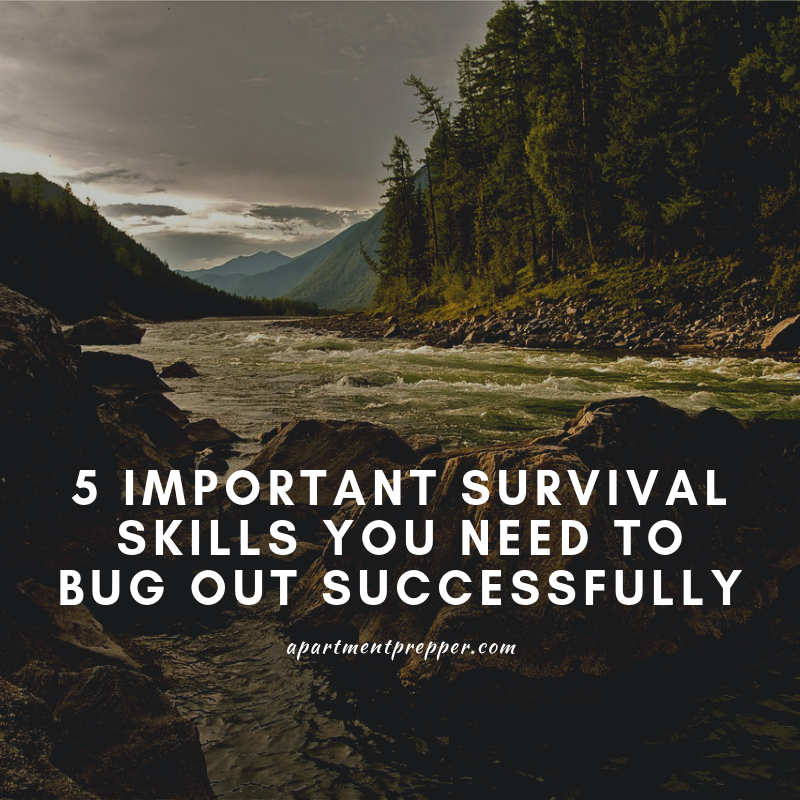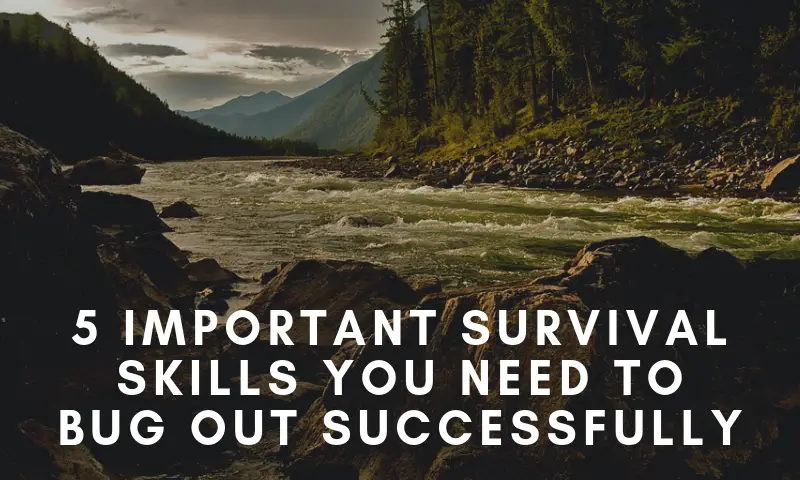Guest post by Peter Betts, The Survival Hacks
Outdoor survival skills are not commonly taught, but they can potentially save your life especially during disasters. Imagine being forced out of your home due to tornadoes, floods or floods, you and your loved ones have no choice but to bug out for at least a week seeking external shelter.
However, knowing the right survival skills is equally critical, as well as having the right survival gear. It’s often the case that you need a suitable bug-out bag that is packed carefully for long-term survival, which you can learn more about here.
What are survival skills? In short, they are techniques to ensure your personal safety and basic needs such as food, water and shelter are met. Here we are going to discuss the 5 important survival skills you need to bug out successfully.
1. Getting Clean Water
The human body is made mostly of water. Water helps regulate our body’s temperature and protects our tissues, spinal cord and joints. We quickly become dehydrated when bugging out as our body loses water through breathing, sweating and digestion.
Extended period of dehydration would lead to rapid heartbeat, sleepiness, feeling dizzy and fainting. If this prolonged to just three days, the human body would shut down indefinitely. What’s worse? Drinking contaminated water which results in abdominal cramps and vomiting. Hence, it is of utmost importance to get and purify drinking water to maintain one’s survival when bugging out.
First and foremost, we need to look for signs of water sources. If you are in the wilderness, observe the terrain slopes as water runs downhill. Look for animal tracks which could lead to potential riverbank and streams. Another option is to collect rainwater which minimizes the risk of bacterial infection if you did not filter the water. Having containers and poncho tied to corners of trees can help in water collection.
After collecting your water, I would suggest using a portable water filter to purify it before consuming. Again, this is a matter of life and death, obtaining clean water should be your utmost priority for survival.
2. Making a Safe Shelter
After getting your drinking needs sorted, next is to look at building yourself a safe shelter to camp in. A survival shelter needs to address basic needs such as keeping rain out, maintain heat inside and easily set up using portable materials.
Since you will be bugging out, I would recommend getting a bug out bag to store a survival sleeping bag to keep you warm during the cool nights. Of course, you can also build a basic shelter using just tree branches or laying a poncho over a rigid frame to form a tent-like structure. If you have paracord and a piece of cloth with you, you can consider making a hammock.
In cold weather, hypothermia might set in especially in wet area. If you find yourself exposed to such extreme weather, your main concern is to insulate yourself from further cold and dampness in the shortest period. Having a portable personal emergency shelter would come in handy as it helps trap body heat.
3. Sourcing for food
At this point, you will have realized that having a bug out bag with essential survival gear and food would make life much easier for you. With a preparedness kit, you will have emergency food supply kit which you can consume up to 30 days as it contains just-add-water meals where you can eat it directly out of the pouch.
Assuming you did not prepare any food kit, one can consider eating plants in the wilderness such as stinging nettle, dandelions, burdocks, cat tails and acorns. Some parts of the plant need to be processed, cut and if possible, cook using warm water to remove any bacteria present. Despite the edible properties of these plants, cat tails can also be used as fire accelerant when starting a fire.
4. Building a survival fire
Making a fire is also critical in a survival situation as it provides you heat, light, cooking ability and signalling capability. To create a fire, you would need to look for coconut husks and dry pieces of soft wood. The coconut husks make a great tinder bundle because it is packed with very fine and flammable fibers. If you have a lighter or matches with you, the tinder can then be lighted and placed on a pile of dry woods.
If you do not have any matches, you will need to craft a narrow stick from the same branch of soft wood and cut the tip slanted to 45 degrees on both sides. The crafted stick will then be pushed back and forth onto another piece of soft wood. You should see bits of charred wood and smoke coming out of the soft wood after a few minutes of back and forth motion. Lastly, transfer the coal from the wood onto the husks and cover it. You will see more smokes coming out of your husk. Blow into the husk to speed up the process and you will finally get your flames. I also want to point out that there are different styles of fire lays for survival such as tepee fire, log cabin-style fire and Dakota fire hole.
5. Performing First Aid treatment
What’s next? Having the appropriate first aid knowledge is useful for your survival because we can never predict what might happen when bugging out. One of the worst things is that you injured yourself and broken a bone which can be a disaster if you were running from a prey.
If there is any wound, stop any bleeding by applying pressure to the wound with a clean cloth. Don’t attempt to realign the bone that’s broken or sticking out. Instead, apply a splint to the area above or below the fracture which allows you to be mobile without causing further damage to the broken body part. Having an ice pack would be useful for this situation as it can limit swelling and relieve some pain.
Conclusion
Learning these 5 essential skills you need to bug out successfully will significantly increase your chances of survival. Investing some time and resources in learning these skills and a preparedness kit would be useful as the emergency kit can be tailored to your environment. In short, these 5 survival skills revolved around the human basic needs which are water, shelter, food, warmth and emergency first aid treatment in the case of injury. Outdoor survival requires both skills and the right mental attitude such as maintaining positive thinking, setting survival goals and braving through adversities. With these skills and attitude in place, I can assure you that your success rate of survival is much higher than anyone else.
Author bio:
I am Peter Betts, a survivalist and outdoor enthusiast. I spend a lot of time learning about what’s the best tips for surviving. It’s an endless learning process. If you want to learn more about me, you can follow me over at The Survival Hacks.
Image by Free-Photos on Pixabay



